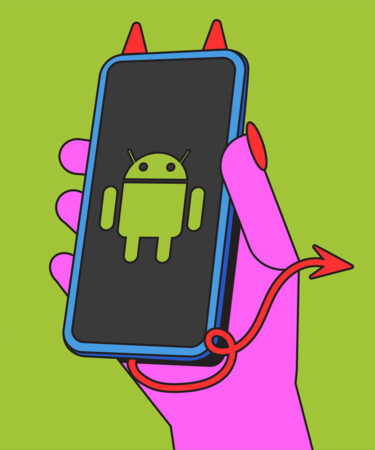This article is part of our Cocktail Chatter series, where we dive into the wild, weird, and wondrous corners of history to share over a cocktail and impress your friends.
Technology is an integral part of day-to-day life in the 21st century, so it’s no surprise that cell phones, laptops, and tablets frequently show up on screen. And if one brand is winning the placement war, it’s Apple. According to U.K.-based entertainment media market research company Concave Brand Tracker, Apple was the most featured brand in movies and TV shows in 2023, and it has made the top 100 list since 2014. But while some characters might be depicted firing off blue-bubbled iMessages to their friends or joining a FaceTime call, others will likely never even hold an iPhone thanks to a few guidelines filmmakers must follow when capturing the brand in a scene.
Referred to in the entertainment industry as the “no villain clause,” producers allegedly must agree to only depict the Apple products “in the best light” when they’re used as props, and in “a manner or context that reflects favorably on the Apple product and on Apple Inc.” That means you won’t catch a serial murderer in a crime drama overtly fielding calls on an iPhone. Moreover, according to Apple’s Guidelines for Using Apple Trademarks and Copyrights, individuals “may not use an Apple trademark or any other Apple-owned graphic symbol, logo, or icon in a disparaging manner.”
While the tech giant has yet to confirm or deny the existence of the “no villain clause,” Apple does have a say in how it’s represented during production. Not only does it own the rights to its various trademarks, but Apple doesn’t pay for product placement. Instead, the brand hands over its iPhones, iPads, Macbooks, and more for use on sets free of charge. The rumored clause was referenced by American filmmaker Rian Johnson in a 2020 interview with Vanity Fair while promoting murder mystery “Knives Out.”
“Apple, they let you use iPhones in movies,” Johnson said in the interview. “But — and this is very pivotal — if you’re ever watching a mystery movie, bad guys cannot have iPhones on camera.”
Other industry professionals have told similar stories of navigating the clause. In an August 2024 interview on the podcast “Wrap Drinks,” prop master Heidi Koleto (“Barry,” “Julia,” “Kevin Can F*ck Himself”) alleged that a scene in one of the shows she worked on needed to be changed to adhere to Apple’s stipulations.
“I got a script once where an actress is supposed to be looking at her phone while she’s driving drunk and crashes her car,” she explained. “They wanted to see a text message pop up and I had to be like ‘We can’t do that. We’ve established this character with an Apple phone. We can’t have her driving drunk and crashing while looking at an iPhone, they’ll never work with me again.” She explained that producers had to add a sound overlay mimicking the alert of a text message — without ever actually showing the phone — before the crash took place. Koleto also alleged that Apple even dictates what kinds of cases, if any, prop departments are allowed to cover iPhones with.
To get around these restrictions, some filmmakers and showrunners opt to have characters use Androids or flip phones, depending on the film or series setting. So pay close attention next time you head to the theater to catch a thriller — if someone’s using an iPhone, odds are they’re not the bad guy.
*Image retrieved from A_B_C via stock.adobe.com
